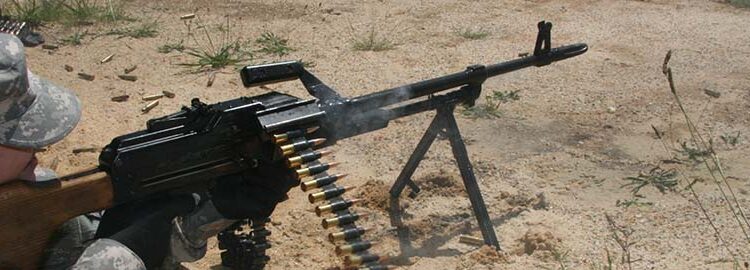By Robert Bruce
In the previous issue, we provided an in-depth look at this unique organization, the only one of its kind and size in the U.S. Armed Forces and probably anywhere else. Now, let’s join the 203D’s latest Technical Intelligence Operators Course for a glimpse at their wartime mission of Sensitive Site Exploitation and some exciting training in the Foreign Weapons module.
“You’ve probably spoken to enough people in the military to know that previous generations owned guns, hunted for rabbits and deer. They knew how to use a gun before they came into the military so it’s not a big deal for them to get into the Army and shoot an M16. But we now get a lot of city kids and others who never even touched a gun until they joined the Army. They’ve seen the AK47 on some video game and now they get to shoot it. Pretty excited about that and I could probably go next door (to where the class is ongoing) and ask who has actually bought a gun since getting to the 203D. Quite a few who’ve said yes.” Sergeant First Class Danial Stanley, TIO Course weapons instructor
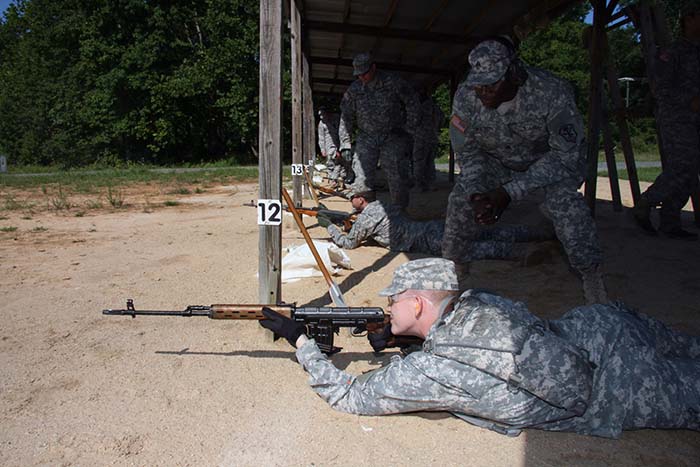
Foreign Weapons and More
While the battalion’s mission and capabilities go well beyond collection and identification of enemy materiel, the hook for us gun guys is, of course, exotic weapons, ammo and related equipment.
SAR eagerly accepted an invitation to visit Aberdeen Proving Ground, Maryland, in August to sit in on the last three days – particularly the Foreign Weapons block – of the most recent Technical Intelligence Operators Course. This 12 day full-immersion school is primarily for officers, warrants and enlisteds holding an intel MOS (Military Occupational Specialty), but is open all those who are assigned to TI teams. “Outsiders” may also attend if justified and if space is available.
The course provides a historical overview of TECHINT, its role within the intelligence community and its application throughout the Department of Defense. It includes familiarization training on Foreign Weapons and Vehicles.
Using a combination of classroom lecture and hands on practical exercise, students are introduced to Weapons Technical Intelligence (WTI), Sensitive Site Exploitation (SSE) to include Document and Media Exploitation (DOMEX), battlefield forensics and biometrics, as well as IED familiarization.
Students learn how to operate on a TECHINT team, employ TECHINT tools and equipment and create TECHINT reports and target folders. Upon completion, soldiers will have a baseline knowledge of TECHINT operations and exploitation of TECHINT materiel.
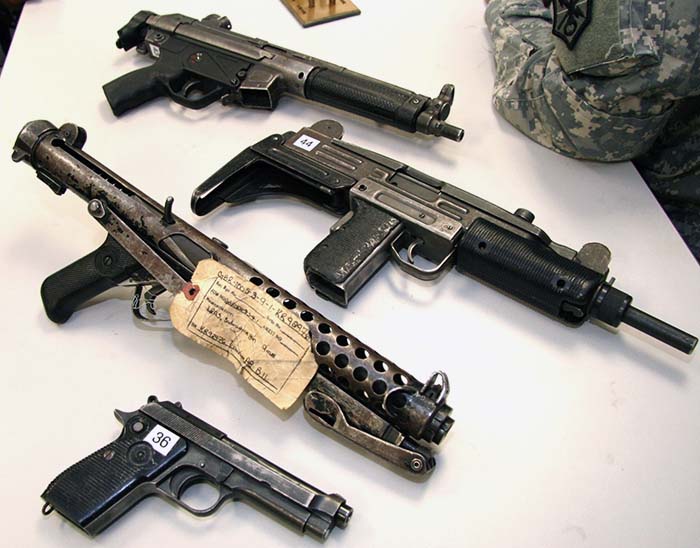
Sensitive Site Exploitation
“The good thing about this unit is the entire battalion is based on TECHINT. When I get back to Charlie Company, if they want me to be an instructor or keep pushing forward that’s what I’ll do. I’ll pass along the information that I have learned. What some of the other soldiers think we do may not correspond to what we actually do. So I’ll make sure they have that clarification; who we are, what we do and how important it is to keep the 203D alive.” Sergeant Channing G. Walton, TIO Course student.
We caught up with the current class’ teachers and about two dozen students “behind the fence” in Aberdeen Test Center’s vast and highly restricted real estate that’s reserved for experiments with all manner of classified weaponry, vehicles, ammunition, and much more that nobody’s supposed to talk about. So we won’t.
Sergeant First Class Danial Stanley, lead instructor, introduced himself and explained the afternoon’s practical exercise in SSE – Sensitive Site Exploitation. This proved to be something akin to a tactical military version of a crime scene investigation.
Teams of TECHINT trainees were rotating through a series of stations in a MOUT (Military Operations on Urban Terrain) site, a suitable stand-in for facilities typically encountered in Iraq, Afghanistan and elsewhere in CENTCOM’s area of operations.
Each station in the various buildings presented a set of different challenges in collection and interpretation. “Clues” to enemy capabilities and likely intentions were scattered around in the form of computers, weapons, IED components, authentic looking documents, and even money. Instructors as insurgent role-players provided the opportunity for quick interrogation and collection of “biometric” data with a high-tech tool called a SEEK II — Secure Electronic Enrollment Kit and Multimodal Identification Platform.
This GO/No-GO exercise was the culmination of all the school’s instruction so far. Pressure was on and the teams went about their prescribed taskings with seriousness and a sense of urgency. Afterward, despite some constructive criticism in after action reviews, instructors delivered the welcome news that all had made the grade.
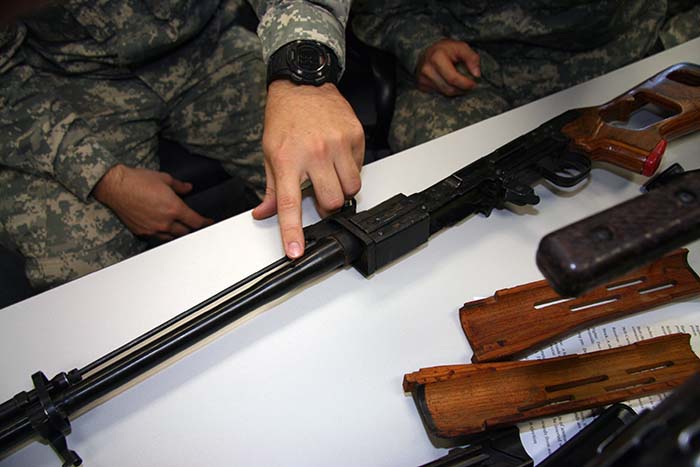
Guns, Guns and More Guns
The following day was all classroom time, kicking off the first component of the Foreign Weapons block of instruction that occupies the last two days of the course. Not as an afterthought, we were told, but as an eagerly-awaited reward for long hours of schoolwork and practical exercises.
It began with each student giving a five to ten minute talk on the weapon of his or her choice from the curriculum. As expected, we got lots of interesting perspectives on the origins, mechanical characteristics and combat history of perennial favorites like the Soviet bloc’s SKS, AK and variants, as well as belt-fed designs.
While all got a “GO,” it was easy to appreciate those for whom the assignment was much more a pleasure than a chore. Our favorite was one with PowerPoint graphics tracing evolution of the intermediate cartridge and its diverse launch platforms from the WWI Pederson Device to Mikhail Kalashnikov’s iconic AK.
Then, SFC Stanley held forth in an all afternoon marathon session with his own detailed presentations of these and some other decidedly different non-U.S. military firearms. All students got hands-on time with the subject weapons – primarly AK-47, AK-74, RPK, SVD, and PKM – to include field stripping and examination of the inner workings. Other weapons were introduced including the FAL, G3, MP5, Uzi, RPG, as well as the Iraqi Tariq and Tabuk.
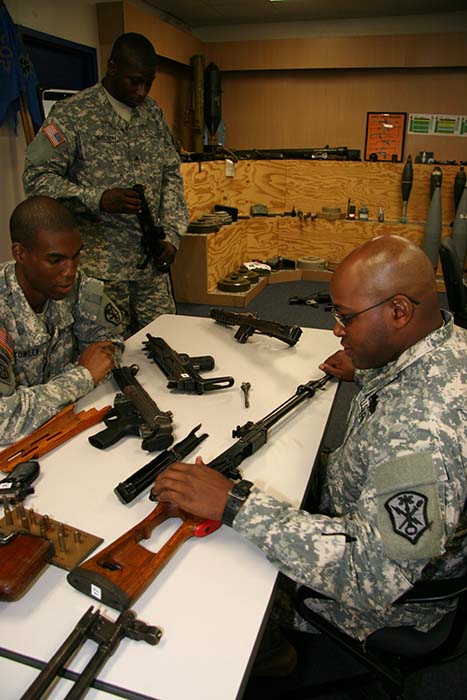
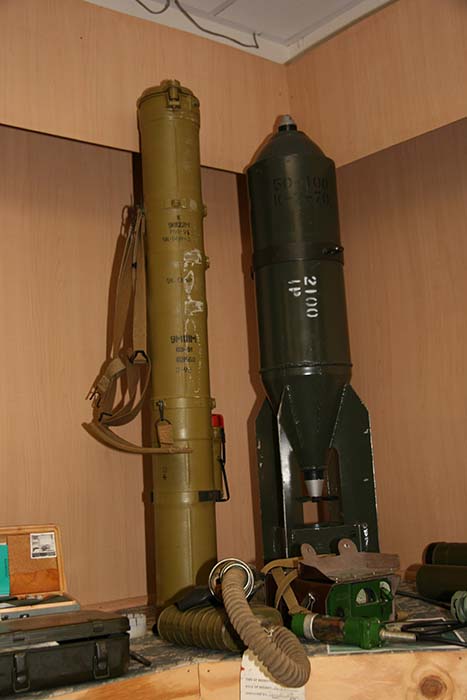
On the Range
While any day of live fire, no matter how awful the weather, is better than being in the classroom, the following morning dawned mercifully cool and partly cloudy. A distinct and most welcome departure from Maryland’s typically hot and muggy August climate.
The instructors and support staff busied themselves setting up the range and bringing out the guns and ammo. With only 5.45x39mm and 7.62.54R available (somewhere along the line the battalion’s request for 7.62x39mm was not approved), the training day’s launch platforms included a pair of AK-74s, an SVD and a PSL/FPK, plus two PKMs.
But filling dozens of magazines and piles of belts over and over again for all these eager shooters is no small matter. Particularly since the rifle cartridges weren’t on strippers and someone forgot the belt loading machine. Not to worry though, first staffers and then students stepped up to take turns with the thumb-busting task and nobody’s weapon up on the firing line went dry.
Students and their invited guests came in on busses, with the latter settling in on benches for welcoming remarks and to observe presentation of graduation diplomas to each student. Then, following long-established procedure for groups participating in Foreign Weapons Familiarization, selected students each stepped forward in turn to introduce one of the day’s four weapons.
While guests looked on from the bleachers, students were evenly divided into groups and lined up behind weapons positioned on the firing line. For the next forty five minutes the air was filled with the sharp rapping of semiautomatic and automatic weapons fire along with the distinctly sweet smell of burning nitrocellulose propellant.
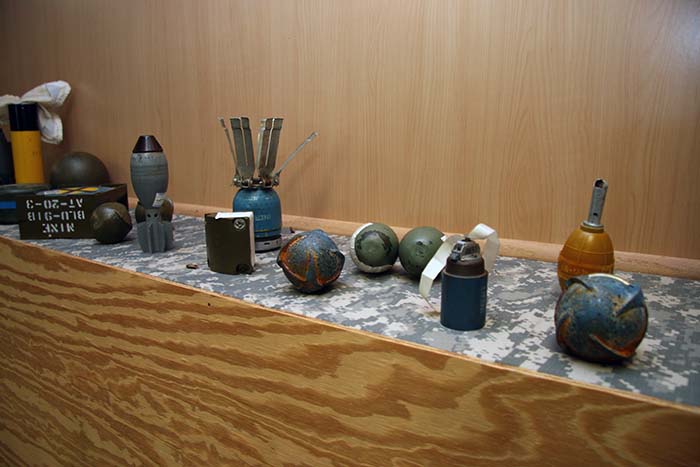
Quality Time with the Family
After all students, except for designated lane coaches who had to stay with their assigned weapons, rotated through all of the stations, it was time for the family members and other guests to get some trigger time. Wives, children, friends, and an assortment of military, law-enforcement and civilian invitees eagerly lined up to shoot some decidedly exotic weapons that most of the public will only see in videos.
Under close supervision and wary vigilance of the lane coaches, some folks who had never fired as much as a squirt gun got to pump out bursts from a Russian assault rifle, squeeze off powerful rounds from a sniper rifle, and blast a belt through a Soviet medium machine gun – all courtesy of the 203D.
For those who may call into question the expenditure in time and materiel to do this, we counter with the “good training” rationale. Students conducting this hands-on familiarization firing were doing it right by the SOP (Standard Operating Procedures) for the battalion’s FW training mission. Think of it as a practical exercise combined with spreading awarness of the battalion’s capabilities among a variety of entities and certainly some morale-building family support.
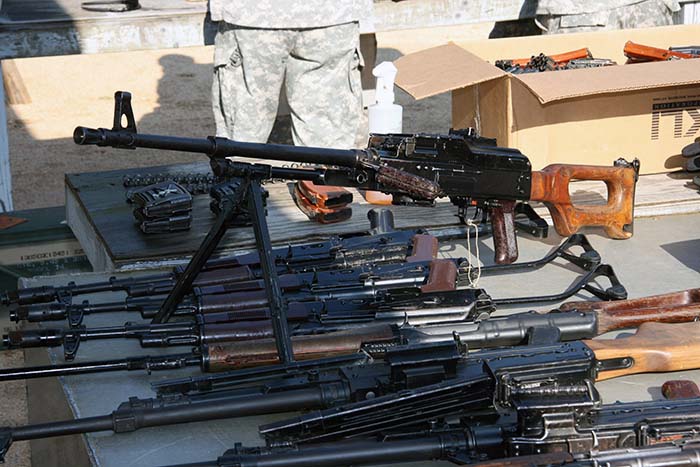
Hard Core Weapons in Action
After most of the students and all of the guests departed, lane coaches finally got to break away and settle in behind each of the other weapons. This is when Sergeant Channing Walton, who had developed a particular fondness for the PKM but was inexplicably assigned to coach the SVD, got his ammo burn time with Kalashnikov’s excellent belt gun.
This big, burly-framed former Marine and former civilian police tactical team member had experience with both the 5.56mm M249 SAW and the 7.62mm M240. He was determined to use his live-fire time with the PKM for an informal comparison. And his verdict? “It’s a good one,” Channing said, flashing his characteristic 100 watt smile.
Carefully rationing available ammunition had produced two desirable outcomes: Everyone got to shoot an adequate number of rounds for familiarization, and a small but useful stock of the big 7.62x54R stuff remained
This was time for a graphic demonstration of the Soviet PKM’s toughness and versatility in the same category as the U.S. M240. Remaining belts were strung together and loaded into the gun. Instructors, staffers and remaining students gathered to watch the endurance firing. Approximately 250 rounds were rapidly and flawlessly sent downrange without so much as a hiccup. Yes, the barrel was smoking, but not heated beyond safety limits.

Need Foreign Weapons Training?
An important part of the 203D’s mission is to send out mobile training teams to conduct foreign weapons training for authorized units in DOD and other entities. Depending on available funding and other factors, this can be done at a location specified by the requestor, or at Aberdeen Proving Ground, Maryland. For details contact: Commander, 203D Military Intelligence Battalion, ATTN: S-3, 4247 Deer Creek Loop, Aberdeen Proving Ground, MD 21005. Telephone (410) 278-7832 Email ulisses.taymes.mil@mail.mil
Interview:
Sergeant First Class Danial “Danny” Stanley,
Foreign Weapons Lead Instructor, 203D’s Technical Intelligence Operator Course
This 45 year old native of West Virginia now makes his home in Harpers Ferry, WV, and commutes each workday to his regular job as a civilian employee for a defense contractor at Fort Meade, MD. He’s a former Navy Hospital Corpsman who went into the Army in 2000, and then the U.S. Army Reserve. Total service 26 years.
SAR: How did you make your way into the 203D ?
Stanley: A USAR recruiter found a 45B position (small arms and artillery repairer) in 203D. When I found out we were tech intel dealing with foreign weapons I never left. Probably never will. I deployed with 203D to Operation Iraqi Freedom. My current duty position is Senior Technical Analyst and I’m a platoon sergeant in Delta Company.
SAR: Has your current assignment lived up to your expectations?
Stanley: More than. I really enjoy this place. I get the opportunity to keep current on FW technology and tell new soldiers. I feel like I’m passing knowledge on to the next generation and this is a good place to do that.
SAR: So many different specialties in 203D. Tell us about their appreciation for weapons technology.
Stanley: We do have more than forty different Military Occupational Specialties but I think the one that soldiers tend to like the most is whenever we get to work with small arms. I can show you a T72 tank all day and all the nifty features of it, but when we break out the FWs (foreign weapons), everybody wants to be there. It’s kind of our bread and butter. How does that work? Can I shoot it? Nobody gets to shoot the tank but everybody gets to shoot the guns.
SAR: Can you say you’ve brought people to an interest in small arms through the work that you do?
Stanley: I’d think yes. You’ve probably spoken to enough people in the military to know that previous generations owned guns, hunted for rabbits and deer. They knew how to use a gun before they came into the military so it’s not a big deal for them to get into the Army and shoot an M16. But we now get a lot of city kids and others who never even touched a gun until they joined the Army. They’ve seen the AK47 on some video game and now they get to shoot it. Pretty excited about that and I could probably go next door (to where the class is ongoing) and ask who has actually bought a gun since getting to the 203D. Quite a few who’ve said yes.
SAR: So, for all MOS’ in 203D one unifying thing is small arms?
Stanley: I think so, yes.
SAR: Are you personally interested in firearms and shooting?
Stanley: Oh yes. In my regular job I’m a gunsmith with a large defense contractor, fixing guns for the Army. Depot level maintenance, upgrades, etc., to their standard small arms. No FWs. I keep the guns running for the guys who go downrange.
SAR: How did you get into this job?
Stanley: Found it on Linkedin, searching for keywords ‘gunsmith, armorer.’ I’ve been there 3 1/2 years now. My Army training and knowledge got me in the door and my FW knowledge from 203D is what I think sealed the deal because they wanted someone who knew FWs. Since then I’ve gone to get certifications on a lot of different guns. Glock, SIG, Beretta, Remington, Colt, HK, Knight’s, and three from Long Mountain Outfitters. The way contracting works is my employer pays me to go to the class then they bill the Army.
SAR: Back to personally interested in firearms and shooting.
Stanley: My first gun was one my dad got me; a single shot .410 (shotgun) when I was twelve. My first personally purchased gun was a (Ruger) 10/22. The first deer rifle I bought got me curious about how they work and why this is not considered an ‘assault weapon’ but that one is. I went to the gun store and told the man I’d like to buy an inexpensive deer rifle and he sold me an SKS. I asked what that little nub on the muzzle end was and he said that’s a bayonet lug. I said, ‘that’s cool, I think I’ll put a bayonet on there.’ He said, ‘Oh no, you’ll be in violation of the crime bill of 1994 by having a bayonet.’ That turned on the curiosity bulb and I’ve been buying guns and fixing guns, trading and building. I’ve lost count of how many I’ve got in my cabinet since then.
SAR: Preferences?
Stanley: For the most part I really like my AR. Mostly because it’s such a modular gun. I built my own starting with a Rock River lower. By going to gun shows and saying ‘here’s a part I need to complete it. Well, I’m not happy with that,’ and changed it out. I’ve changed fore ends, pistol grips, butt stocks, so many times. It’s currently being remodeled again with a railed fore end, floating system. Flat top upper with M4 feed ramps, Colt heavy barrel. Heavy barrel was great for shooting targets but running up and down range and trying to shoot around barricades the barrel gets hot and heavy pretty quick. I’m probably going to build myself a short upper with a just long enough flash hider to keep it legal. Semi-auto, of course.
SAR: Handguns?
Stanley: My daily carry is an HK P2000 SK in .40 S&W. It’s compact, fits good in my hand, put it in my waist without an issue. I like the reliability of the HK. I like .45 cal., but if I’m going to get one the only logical choice is a classic 1911. But a little too big to carry on a daily basis. So the HK in .40. More powerful than 9 millimeter and we’ve known for a hundred years that the 9 mil sucks but we keep using it. Kind of a happy medium between a 9 mil and a .45. I work in the ‘Peoples Republic of Maryland’ (restrictive gun laws) so I can’t carry when I’m going to and from work. But when off duty and home in West Virginia, I carry all the time.
SAR: What formal schools and subsequent training have you received for your duties?
Stanley: Factory schools for Glock, SIG, Beretta, Remington, Colt, HK, Knight’s, and three from Long Mountain Outfitters. LMO’s Matt Babb’s a great instructor. I’ve picked up a lot of good points from him. Also, Dr. Phil Dater’s Silencer Technology class there. He‘s a great teacher, shed a lot of light on the inner workings of suppressors. Not just a tube with baffles – here’s how it works. I’m about to go to a fourth one next month; LMO’s week long FW operator/armorer course.
SAR: LMO’s FW course because you haven’t had enough of that at 203D?
Stanley: Well, you can teach yourself only so much. Even though I might have worked with them enough and taught myself everything I think there could possibly be to learn on my own; and I‘m not by far anywhere near that level. I could have a self-taught PhD in firearms but without a certificate no one wants to hire you based just on the knowledge you might have in your head without some paperwork to back it up. I’m getting the certificates for liability purposes.
And now I’m almost done with an online Associate Degree in firearms technology through Sonoran Desert Institute – fully paid for by the Army’s tuition assistance program. It’s mostly theory, but they also send me things to work on. I got a stock with a checkering kit, punch and hammer set, bore site, Dremel tool, etc. I don‘t have time to take off two years to attend a formal, in-house gunsmithing school.
SAR: Briefly comment on key weapons that are featured in the course and why these in particular.
Stanley: For the most part the course focuses on the most common on the battlefield; the AK, G3, SKS. Basic families and variants. Those are the ones we’ll most likely encounter. Our goal is to learn about new technologies and see if they have practical advantages. We can’t know if anything is new, we can’t know the unknown until we know the known. If we know all the variants of the AK, and we know all the variants of the G3 family of firearms, and the FAL, then, if we see something that kinda looks like a FAL and kinda looks like a G3 – a Frankenstein thing – then we know something new has come out.
The two days of FW training in the course gives you a taste. I think the only way to get good at is it to learn more of it yourself. Everybody in this unit probably ought to get themselves a copy of Jane’s Guns Recognition Guide or subscribe to Small Arms Review. Or at least get some back copies. Jane’s is a great reference but it’s still the same as the edition I bought twelve years ago. If you could thumb through some back issues of SAR you’ll probably catch some emerging technology from that. A good reference library.
SAR: Within the weapons specialty at 203D, there must be much more emphasis on what’s newest and best. How is that addressed in the command and specifically in your position?
Stanley: We share the building with NGIC – the National Ground Intelligence Center. They have a foreign weapons reference collection across the hall from where we work. They get new and old guns from time to time. We’ve got a pretty decent relationship with them and when something really neat comes in they’ll call and Chief Warrant Officer Grogan and I will go over and take a look.
For instance, makeshift firearms. There’s not much more to a gun than a tube to make the bullet go downrange, something to hit the firing pin, and a trigger. Sometimes that’s what we’ll find; just enough parts to make it go ‘boom!’ And if it can hit a vehicle and take it out, that’s all that really matters ’cause now everybody’s gotta get out of the vehicle. I’ve seen those. That’s technical intelligence: Who built this, where did the parts come from? You find some makeshift firearm and the pistol grip came from a Black and Decker drill, firing pin is a welding rod, the barrel is a spare from an M2 .50 cal. dropped along the roadside. They put it all together and the next thing you know they’ve got a makeshift .50 caliber sniper rifle.
SAR: Is it correct to say that a lot of what’s at NGIC was collected by the 203D?
Stanley: Yes. I’ve been with the battalion for quite some time and we went over in 2003 to Iraq and we collected a lot of stuff for the Priority Intelligence Requirements List. Essentially a shopping list that says ‘these are things the Coalition Forces would like to have.’ For example, NGIC would say we want to have the following guns and five of each. So we sent home planeloads of guns to the U.S., and to whoever put out their wish list.
Interestingly, Australia said we want five Makarov pistols. Nothing unusual, just standard 9x18mm. So we found and shipped ’em.
SAR: Any unusual weapons?
Stanley: I didn’t see a lot of unusual stuff. When we were over there it actually got kind of tedious. As much as I’m into firearms, I’ll tell you that after staring at CONEX box (large steel ocean shipping containers) after CONEX box of AKs – surplus East German AKs that were outfitting Sadaam’s army.
I saw in a warehouse an M1 Garand rifle that was presented to Sadaam Hussein by Richard Nixon. It had a plaque on it. I thought that was kind of neat – here we are going after the guy who used to be on friendly relations. It stayed there because it had no technical intel value. Who knows what happened to it.
I saw a couple of 12 or 14 foot long “punt guns,” shotguns with a two-inch bore. I thought that was kind of funny.
We sent home a couple of crates of brand new in the box Al Kadish sniper rifles. Iraqi version of the SVD but kind of like a Frankenstein cross between the SVD and the PSL. The SVD is milled but the Iraqis decided to make a stamped version, kinda hokey. But they all had red plates on the bottom of the pistol grip with lettering in Arabic. None of us knew why but we were curious and we took them apart. Every one had a hole drilled through the barrel just beyond the chamber. So the second you pulled the trigger the bullet would go about three eighths of an inch and blast out the sides of the hand guards. There are a lot of theories about why they appeared to be sabotaged or who knows what. Some believed that Sadaam would give these to people as “gifts” because he was a twisted dude hoping the people would shoot ‘em and blow a thumb off.
We found them in an infantry training facility and I feel like it was homework. They were sniper rifles in a loose sense of the term and my theory was the trainers would have the students practice their trigger pull with these guns. A lot foreign militaries have a high desertion rate and when they do, a lot of times they take their guns with ‘em.
Somebody finally told me that the translation (for the lettering on the red plates) was “training.”
SAR: Can you tell us about some of the interesting weapons that you have seen at NGIC?
Stanley: I can’t tell you. There’s some pretty neat stuff over there but… I’ve mentioned that I’ve gone to some training at Long Mountain Outfitters and I’ve seen Dan Shea’s Working Reference Collection. It’s pretty neat. And I’ve seen some guns that he has that I have seen in other places and I’ve been told, ‘Hey that’s classified.’ It’s not so much that the technology is classified but the fact that the U.S. Army has something like that is classified. If we told the world that the 203D and NGIC have this latest, greatest evolution in Russian firearms technology then they’d say, ‘well that cat’s out of the bag. Let’s work on something new.’ It’s ok that he (Dan) has it but the U.S. Army is not supposed to acknowledge that they have it. However you have to rephrase that (laughs).
SAR: Unusual ammunition?
Stanley: We went to a warehouse in Iraq and found cases of wooden rounds. Fluted cases and wooden bullets. (Old style 8mm Mauser type training blanks?) We brought back to our collection point thousands of tons of ammo. If it was questionable it would go to EOD for destruction but a lot was sent to Aberdeen to be used for testing. If some company says they’ve got a new bulletproof vest that will stop those Russian AK rounds, then someone takes it down from the shelf for testing. Standard ammunition but it got used for tests that save soldiers’ lives. New body armor, new vehicles. We’d gather up several crates of RPG7 rounds and they come here to Aberdeen and do penetration tests to see if BAE’s truck will actually stop it.
SAR: We understand there’s some difficulty lately in 203D getting 7.62x39mm ammo for the course’s live fire component and to conduct MTTs.
Stanley: With restructuring and trying to save some money here and there, somebody at a higher level is trying to figure out which of these missions is critical and who should be doing it. I think that MTT (Mobile Training Team) mission is kind of getting squabbled over right now as to whether the 203D or Special Forces to be teaching it. Might cost us all our ammo.
We sent a MTT out to Utah a few months ago. We just brought guns and they supplied all the ammo. A lot of ammo.
SAR: Do you have any particular favorite from the foreign weapons that are part of the course? If so, why?
Stanley: I think my favorite is the AK. It’s probably cliché for me to like the AK but it’s just a reliable gun. The tank of firearms. I wouldn’t say it’s indestructible but you can’t beat ’em. The AK 47 and the M1911. I mean, what could go wrong with them? I don’t think there is any way to improve it. Can’t beat it. Simple. You can teach a monkey to use it. I think I saw that video on YouTube. I’ve seen some newer versions. The Polish version is great.
SAR: What advice do you have for students preparing for this course?
Stanley: What we teach here only scratches the surface and we can’t possibly teach you everything you need to know in just two weeks. It’s important that everybody who takes this course does a little homework on their own. The reason we have so many MOS’ (Military Occupational Specialties) here is you’re supposed to be good at your MOS and use that knowledge of American equipment within that MOS to learn about and exploit foreign equipment. If you’re a commo technician you should know American radios really well and be able to look at a foreign radio and figure out what it does. I know American weapons and I know foreign weapons. If I look at foreign weapons I should be able to tell, ‘hey, there’s something new.’ Learn more about it. You can’t possibly learn this one weekend a month or on a two week span one time a year. So if your MOS is fixing guns, go buy a Jane’s manual on guns. Radios, go buy one on foreign radios and learn about it. Our medics – their primary duty here is not to be a medic. It’s to exploit foreign medical materiel. Look at their first aid kit and compare it to ours. Are they prepared to treat battle wounds or not. If we see some dead guy on the field with no visible signs of trauma. Do some kind of a quick necropsy and find out how he died. My advice is to study and learn more on your own. Develop a passion for MOS and your foreign counterpart’s MOS. Prepare yourself for the day when someone asks you, ‘what does that tan box do?’
As a Platoon Sergeant I really enjoy getting with a new soldier who just got out of initial entry training and comes to the unit and asks, ‘why am I here and what do I do?’ It’s gratifying to see them progress through their days of ‘just got out of school, doesn’t know what’s going on,’ to seeing them teaching someone else what I just taught them. When I see a soldier doing what I told him and the way I told him to do it, knowing he’s going to tell someone else what I told him and the way I told him to do it, I feel like I have done my job. They’re going to succeed me, and someone is going to succeed them and there’s continuity.
SAR: So everybody who comes into the battalion – officer and enlisted – has to go through the TIO course?
Stanley: Yes, that’s a recent development. I’m glad to see that happening. I’ve seen people here for two or three years struggling. Asking ‘why the hell am I here?’ Now they go through the course and the light goes on. They realize they actually do have a purpose.
SAR: Is it a challenge to keep these soldiers motivated when they think they might never deploy to do the TI mission in real conflict?
Stanley: It is sometimes frustrating to think you’re training for something that might never happen.
(At this point we were joined by Chief Warrant Officer 2 Nathan “Nate” Grogan, the 203D’s Armament Systems Warrant Officer)
SAR: Rather than specific questions, tell us about your portion of the 203D. What you do and how you do it.
Grogan: My biggest focus right now is trying to continually refine and improve the foreign weapons training program. Not just on small arms, but anything that has to do with weapons in general. From pistols up to artillery. My MOS is a 913 Alpha, Armament Systems Warrant Officer, assigned to the S-3 Operations section. A good position to be in for what I’m trying to do.
SAR: Do small groups or teams get deployed these days?
Grogan: Not currently, but we’re actually trying to change that.
Stanley: Trying to get restructured so we can get deployed. Intelligence is global. Look at the news and see that there’s stuff brewing all over the place. It’s just a matter of time before someone says, ‘Hey 203D, you’re needed in North Korea.’
SAR: The question then is how to keep these young soldiers who are coming into a reserve battalion motivated? From what you’re telling us, the TIO course is a good part of that. It shows them the bigger picture, how they fit in, what happens when they would be deployed, what they would do, why it’s important when all the info goes back to be shared throughout the intelligence community. Right?
Stanley: Yes. And when a soldier finishes his class we don’t really consider him an actual subject matter expert (SME) at that point. This isn‘t official jargon but I‘d consider them a junior SME or SME in training or development. When they go back to their companies (in the battalion) we start assigning them classes; ‘I want you to teach Module 12 from the course.’ We have better access to the foreign small arms than the vehicles. We can’t just go over there on a Saturday afternoon and say, “Would you mind if we check out the ‘zoo?” (Soviet ZSU-23-4). We have to make arrangements ahead of time for (NGIC’s) contractors to move it out from that side of the fence. But we can tell Specialist Brown to go teach a foreign weapons class on how to field strip an AK47. We get the armorer to sign out a couple of AK47s for the day.
(Grogan explains challenge of this RC unit’s yearly training plan that often gets changed along the way and that creates challenges in access to vehicles and equipment. Talks about the desirability of changing 1 weekend a month to a week a quarter so soldiers are training when full-timers are at work. Both Grogan and Stanley agree that the unit’s 2 week annual training period works reasonably well in this regard.)
SAR: The purpose of this article in SAR is to explain the 203D’s mission, capabilities and what the battalion has to work with as a reserve component entity that is unique to the entire Army. There is no active duty Army counterpart. You guys are it. With that in mind, we want to know how you accomplish the mission based on the realities of what you have to work with. It’s not to pick you apart. It’s to say ‘this was an active duty command that was transitioned to RC. The only one the Army has. This is what they do, how they do it, and this is what they have to do it with.’ As with any unit, even the best-equipped, funded and staffed active duty unit, there are still things they’d like to have. The focus of what SAR is here to do is not, ‘this is where they’re missing the mark,’ it’s ‘this is what they’re faced with.’
(Grogan points to the Battalion Commander’s statement regarding challenges:
“We take great pride in being the Army’s only Technical Intelligence battalion and the opportunities we have to operate in a Joint, Interagency, Intergovernmental, and Multinational environment. Fulfilling our missions as a completely Army Reserve unit does come with challenges, most significantly is our status as an “Always Available” unit. This requires we be ready at all times to deploy in support of Overseas Contingency Operations. Our Soldiers understand this challenge and this serves as a clear motivator for them to maintain their individual readiness as the unit’s leadership focuses on operational support and training opportunities that maintain our mission readiness.” )
Grogan: Twenty years ago this was a full active duty unit. Soldiers would come in already knowing their MOS. Their full U.S. Army job. Usually pretty good at it and had advanced to E5 or E6 (Sgt. or Staff Sgt.). They’d get assigned to the 203D and be in training status for about a full year to learn their full-blown TECHINT MOS. Stanley: Even down to the level of getting foreign vehicle operators licenses.
Grogan: I know this because some of the civilians who work at NGIC right now and some of the people I worked with at ATC (Aberdeen Test Center) are 203D alumni. That’s how it used to be. The challenge is now with it being Reserves, you bring in a soldier who has never done his job on active duty full time. He comes straight out of Basic and AIT (Advanced Individual Training) so the only training he’s had is at the schoolhouse.
Stanley: Also, one of our bigger challenges comes in addition to doing our unique mission; we still have to stay trained on the Army’s mission: Shoot, move, communicate. We have to take the soldiers out to the range twice a year to get qualified on their M16s, remind them this is how to work the radio, maintain proficiency in standard soldier skills. Also physical and medical readiness so once a year somebody comes to conduct screening and that’s one month’s drill weekend shot. PT test takes another. And mandatory briefings. With at least half the year taken up doing U.S. Army stuff we hardly have time to do our foreign materiel training. In between there we try to throw in what the Army calls ‘hip pocket training.’ Out of random nowhere we say ‘let’s discuss this.’ Grab a book and get an AK from the armorer and teach a spontaneous class here and there. We try to put these classes on the schedule but – generally someone higher than the battalion level – will come and say ‘this is what you need to do this month. Sensitivity training or you‘ve got to remind people to not commit suicide.’
SAR: Part of this line of questioning is our misconception that there are still small TI teams being brought on to active duty for a period and sent to Afghanistan or Horn of Africa or wherever. We’ve learned that’s not happening. So that’s removed from the challenge but there are other challenges or difficulties the battalion faces.
Grogan: We’re trying to change that; to put together a team based on intelligence requirements. Get a quick call and get boots on the ground and then run back. A strong possibility. They’re looking at different alternatives for different types of small teams TI stuff.
SAR: What part(s) of the course do students find the most difficult?
Stanley: I asked a couple of students. The one thing that seems to be most difficult is ‘separating wheat from the chaff.’ When we do the practical exercise for site exploitation there’s a lot of stuff in the room. What in that room is important? What do we want to take with us? What to leave behind?
SAR: How are these difficulties overcome?
Stanley: The way to overcome it is just to practice.
SAR: Is the availability of ammunition and range time adequate? We note there is adequate 5.45×39 and 7.62x54R for the other weapons tomorrow, but no 7.62x39mm.
Grogan: The ammunition thing. The transition from a multi-component unit to a pure reserve unit has been extremely rough. The biggest problem we’ve had is the foreign ammunition piece. (But the battalion has all it needs for their organic U.S. weapons). All of the ‘red calibers’ are a big headache because in the ‘Big Army’ scope of things they’ll only let you draw ammo for the weapons that are assigned to you. When we were ‘multi-component’ – part active duty, part Reserve – all those foreign weapons we trained with and took to the range were actually signed out on a long term hand receipt from the big NGIC arms room. When something would break or when we needed to train on something else we’d do a swap-over real quick and continue training. So all that ammo was technically assigned to NGIC. The ammunition was there but then it turned into ‘things don’t match up in the system what are you doing?’ And then it goes back to ‘Wait a minute, you’re an MI unit. Why do you need 7.62×39?’ We’d say, ‘We’re technical intelligence,’ and we‘d have to explain that to them.
SAR: What recommendations would you like to make to the chain-of-command that would improve the course? (More time, ammunition, training aids, graphics, other weapons not currently included, etc.). One thing we’ve learned is that the two days of foreign weapons are sort of an add-on at the end of the course. That proficiency is not tested when determining if a student will pass the course.
Stanley: More variety of weapons.
Grogan: For somebody who’s already a small arms guru like Sergeant Stanley and myself…. The weapons we cover are probably the most prolific ones like the AK. They have to be. You’ve got to tailor the training to the soldiers. He may be infantry but he grew up in a city and never handled any kind of firearm until he joined the Army and touched his first M16 in basic training. So, getting his hands on an AK47 and AK74, an Uzi or an MP5 is really great training to him.
| This article first appeared in Small Arms Review V18N4 (August 2014) |



